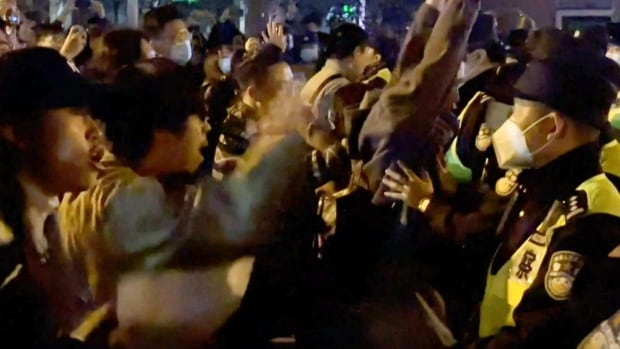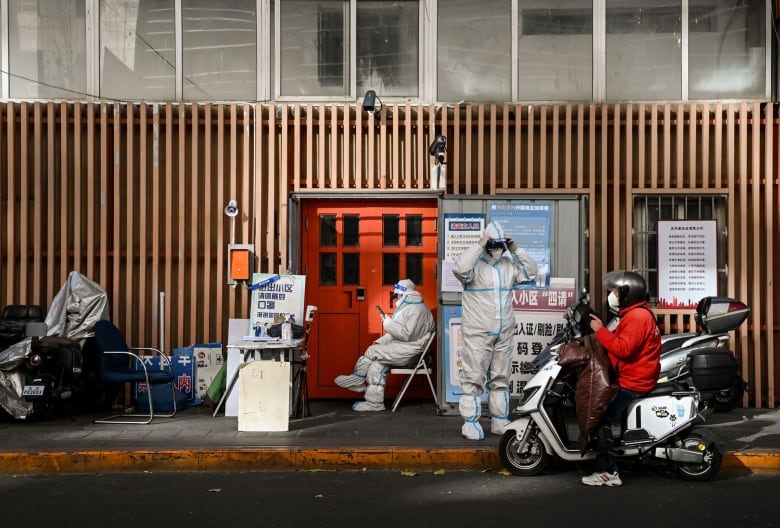
Protests in China against heavy COVID-19 curbs spread to Shanghai on Sunday, with demonstrators also gathering at one of Beijing’s most prestigious universities after a deadly fire in the country’s far west sparked widespread anger.
The wave of civil disobedience — which has included protests in Urumqi, where the fire occurred, as well as elsewhere in Beijing and in other cities — has reached unprecedented levels in mainland China since Xi Jinping assumed power a decade ago.
In Shanghai, China’s most populous city, residents gathered on Saturday night at Wulumuqi Road for a candlelight vigil that turned into a protest in the early hours of Sunday.
The road is named after Urumqi, the capital of the western Xinjiang region where many believe lockdown measures delayed firefighters from reaching the scene of a deadly apartment fire on Thursday. Emergency workers took three hours to extinguish the blaze, blamed for the deaths of 10 people.
As a large group of police in Shanghai looked on, the crowd held up blank sheets of paper — a protest symbol against censorship. Later on, they shouted, “Lift lockdown for Urumqi, lift lockdown for Xinjiang, lift lockdown for all of China!” according to a video circulated on social media.
‘Down with Xi Jinping’
At another point, a large group began shouting, “Down with the Chinese Communist Party, down with Xi Jinping,” according to witnesses and videos, in a rare public protest against the country’s leadership.
The police tried at times to break up the crowd.
At the campus of Beijing’s Tsinghua University, a large crowd gathered, according to images and videos posted on social media. Some people also held blank sheets of paper.

Thursday’s fire in Urumqi saw crowds take to the street on Friday evening, chanting “End the lockdown!” and pumping their fists in the air, according to videos on social media.
Many internet users surmised that residents were not able to escape in time because the building was partially locked down, which city officials denied. In Urumqi, a city of four million, some people have been locked down for as long as 100 days.
China has stuck with Xi’s signature zero-COVID policy even while much of the world tries to co-exist with the coronavirus. While low by global standards, China’s cases have hit record highs for days, with nearly 40,000 new infections on Saturday.
Protest extremely rare
China defends the policy as life-saving and necessary to prevent overwhelming the health-care system. Officials have vowed to continue with it despite the growing public pushback and its mounting toll on the world’s second-biggest economy.
Widespread public protest is extremely rare in China, where room for dissent has been all but eliminated under Xi, forcing citizens mostly to vent on social media, where they play cat-and-mouse with censors.
Frustration is boiling just over a month after Xi secured a third term at the helm of China’s Communist Party.
“This will put serious pressure on the party to respond. There is a good chance that one response will be repression, and they will arrest and prosecute some protesters,” said Dan Mattingly, assistant professor of political science at Yale University.
Still, he said, the unrest is far from that seen in 1989, when protests culminated in the bloody crackdown in Tiananmen Square. He added that as long as Xi had China’s elite and the army on his side, he would not face any meaningful risk to his hold on power.
This weekend, Xinjiang Communist Party Secretary Ma Xingrui called for the region to step up security maintenance and curb the “illegal violent rejection of COVID-prevention measures.”
Xinjiang officials have also said public transport services will gradually resume starting Monday in Urumqi.
‘We want freedom’
Other cities that have seen public dissent include Lanzhou in the northwest, where residents on Saturday upturned COVID-19 staff tents and smashed testing booths, posts on social media showed. Protesters said they were put under lockdown even though no one had tested positive.
Candlelight vigils for the Urumqi victims took place at universities in cities such as Nanjing and Beijing.
Videos from Shanghai showed crowds facing police and chanting “Serve the people,” “We want freedom” and “We don’t want health codes,” a reference to the mobile phone apps that must be scanned for entry into public places across China.

The Shanghai government did not immediately respond to a request for comment on Sunday.
The city’s 25 million people were put under lockdown for two months earlier this year, provoking anger and protests.
Chinese authorities have since sought to be more targeted in their COVID-19 curbs, an effort that has been challenged by the surge in infections as the country faces its first winter with the highly transmissible Omicron variant.
In Beijing on Saturday, some residents under lockdown were able to successfully confront and pressure local officials into lifting curbs ahead of schedule.
One video shared with Reuters showed Beijing residents marching in an unidentifiable part of the capital on Saturday, shouting “End the lockdown!”
The Beijing government did not immediately respond to a request for comment.